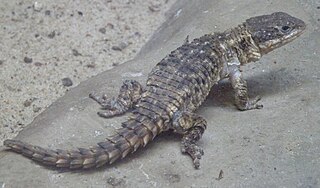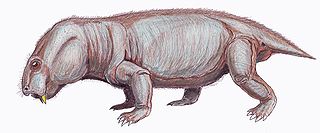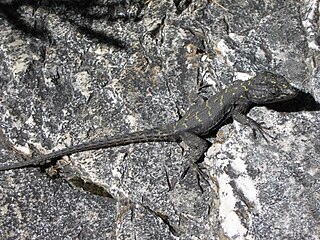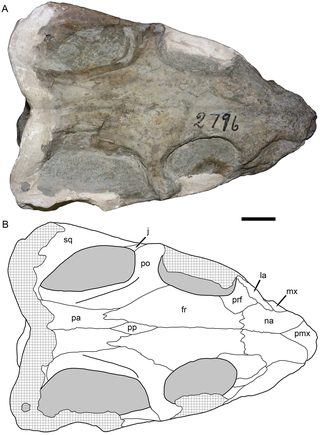
The genus Cordylus includes a wide variety of species of small to medium spiny lizards from Africa, collectively called girdle-tailed lizards or girdled lizards. All are diurnal and ovoviviparous. Most species are rupicolous (rock-dwelling), while a few species are arboreal or live in burrows. They defend themselves with osteoderms and by quickly retreating into rock crevices or burrows. Many species live in groups, and males defend territories.

The armadillo girdled lizard, also commonly known as the armadillo lizard, the armadillo spiny-tailed lizard, and the golden-armadillo lizard, is a species of lizard in the family Cordylidae. The species is endemic to desert areas along the western coast of South Africa. In 2011, it was moved to its own genus based on molecular phylogeny, but formerly it was included in the genus Cordylus.

The Cape cobra, also called the yellow cobra, is a moderate-sized, highly venomous species of cobra inhabiting a wide variety of biomes across southern Africa including arid savanna, fynbos, bushveld, desert and semi-desert regions.

The wildlife of South Africa consists of the flora and fauna of this country in southern Africa. The country has a range of different habitat types and an ecologically rich and diverse wildlife, vascular plants being particularly abundant, many of them endemic to the country. There are few forested areas, much savanna grassland, semi-arid Karoo vegetation and the fynbos of the Cape Floristic Region. Famed for its national parks and big game, 297 species of mammal have been recorded in South Africa, as well as 849 species of bird and over 20,000 species of vascular plants.

The Limpopo girdled lizard, also known commonly as Jones's armadillo lizard and Jones's girdled lizard, is a species of lizard in the family Cordylidae. The species is endemic to Southern Africa.

The Transvaal girdled lizard or Reichenow's spiny-tailed lizard is a very flattened girdled lizard from northeastern South Africa, Swaziland, and southeastern Botswana. It prefers rock outcrops in open grassland and feeds on small arthropods, especially beetles.
Machadoe's girdled lizard is a flattened girdled lizard from southwestern Angola and northwestern Namibia. They are found as solitary individuals or in pairs on rock outcrops in arid savannah. It can be identified, along with Cordylus vittifer, by have an elongate first row of dorsal scales. Machadoe's girdled lizard is uniform yellow brown above and paler below. The head is dark brown with pale lips. The pale vertebral stripe found in the Cordylus vittifer is not present. Adults reach 78 mm in length from snout to vent.

Warren's girdled lizard is a species of relatively large, flattened lizard in the family Cordylidae. The species is native to Southern Africa.

Dicynodontoides is a genus of small to medium-bodied, herbivorous, emydopoid dicynodonts from the Late Permian. The name Dicynodontoides references its “dicynodont-like” appearance due to the caniniform tusks featured by most members of this infraorder. Kingoria, a junior synonym, has been used more widely in the literature than the more obscure Dicynodontoides, which is similar-sounding to another distantly related genus of dicynodont, Dicynodon. Two species are recognized: D. recurvidens from South Africa, and D. nowacki from Tanzania.

The tent tortoise is a species of tortoise and one of three members of the genus, Psammobates. Known locally as the Karoo tent tortoise, this highly variable species is found in South Africa and Namibia.

Chersobius boulengeri, commonly known as the Karoo padloper or Boulenger's cape tortoise, is a species of tortoise in the family Testudinidae. The species is endemic to the Nama Karoo Region of South Africa.

The false girdled lizard is a lizard species endemic to the Cape Fold Belt of southern South Africa.

Hemicordylus, the false girdled lizards, is a genus comprising two lizard species endemic to the Cape Fold Belt of southern South Africa.
Namazonurus campbelli, commonly known as Campbell's girdled lizard, is a species of lizard in the family Cordylidae. A small girdled lizard, N. campbelli is endemic to Namibia. It is often mistaken for the more common Herero girdled lizard, N. pustulatus, as they both are similar in size and have flattened bodies. N. campbelli lives in rock crevices and cracks on dry mountain slopes

Smaug is a genus of lizards in the family Cordylidae. The genus Smaug is a group of species of spiny southern African lizards, separated from the genus Cordylus in 2011 on the basis of a comprehensive molecular phylogeny of the Cordylidae. The type species is the giant girdled lizard, S. giganteus.

Van Dam's girdled lizard is a species of lizard in the family Cordylidae. The species is endemic to South Africa.

Karusasaurus, commonly known as Karusa lizards, is a genus of lizards in the family Cordylidae.

Thliptosaurus is an extinct genus of small kingoriid dicynodont from the latest Permian period of the Karoo Basin in KwaZulu-Natal, South Africa. It contains the type and only known species T. imperforatus. Thliptosaurus is from the upper Daptocephalus Assemblage Zone, making it one of the youngest Permian dicynodonts known, living just prior to the Permian mass extinction. It also represents one of the few small bodied dicynodonts to exist at this time, when most other dicynodonts had large body sizes and many small dicynodonts had gone extinct. The unexpected discovery of Thliptosaurus in a region of the Karoo outside of the historically sampled localities suggests that it may have been part of an endemic local fauna not found in these historic sites. Such under-sampled localities may contain 'hidden diversities' of Permian faunas that are unknown from traditional samples. Thliptosaurus is also unusual for dicynodonts as it lacks a pineal foramen, suggesting that it played a much less important role in thermoregulation than it did for other dicynodonts.

Pedioplanis laticeps, known commonly as the Cape sand lizard or the Karoo sand lizard, is a species of lizard in the family Lacertidae. The species is endemic to Southern Africa.

Smaug breyeri, also known commonly as the Waterberg dragon lizard or the Waterberg girdled lizard, is a species of lizard in the family Cordylidae. The species is endemic to South Africa.




















